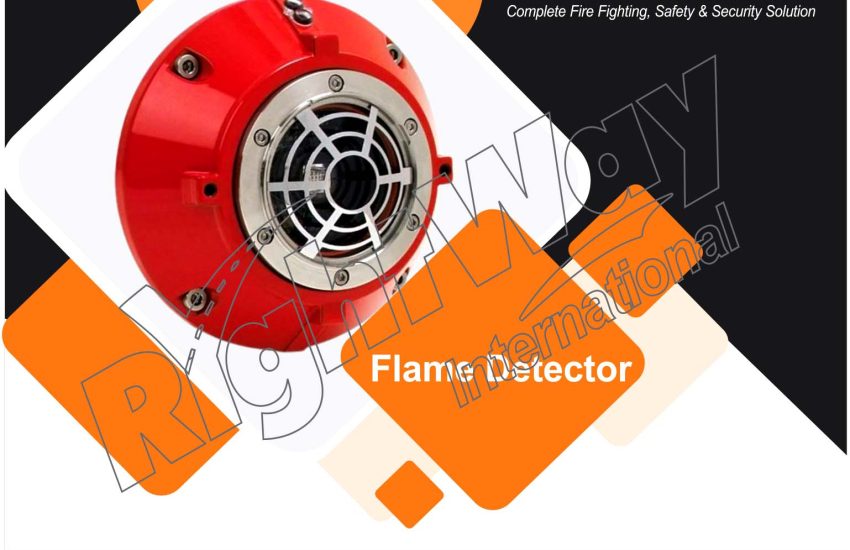Flame Detector are essential components in advanced fire protection systems, designed to detect the presence of flames and provide early warnings of fire. They are especially valuable in environments where traditional smoke or heat detectors might not be effective. This article explores how flame detectors work, the different types available, their benefits and limitations, and best practices for installation and maintenance.
How Flame Detectors Work
Flame detectors use various technologies to detect the presence of flames. They are typically employed in high-risk environments where rapid flame detection is crucial. Here’s an overview of their operation:
- Detection Mechanism
- Optical Detection: Flame detectors use optical sensors to detect the light emitted by flames. They analyze specific wavelengths of light that are characteristic of a flame’s radiation.
- Infrared Detection: These detectors sense the infrared radiation emitted by flames. Infrared flame detectors are sensitive to the heat signature of a flame, which allows them to detect flames even in low-visibility conditions.
- Ultraviolet Detection: Ultraviolet flame detectors detect the UV radiation emitted by flames. They are particularly effective at detecting flames in environments with high ambient light or where smoke is present.
- Alarm ActivationWhen a flame is detected, the flame detector sends a signal to the fire alarm system, triggering an alarm. This alert provides early warning to occupants and allows for rapid response to potential fires.
Types of Flame Detectors
**1. Ultraviolet (UV) Flame Detectors
UV flame detectors are designed to detect the ultraviolet radiation emitted by flames. They are effective in environments where flames are present but might not produce significant visible or infrared radiation. UV detectors are commonly used in applications like gas turbine engines and chemical processing.
**2. Infrared (IR) Flame Detectors
IR flame detectors sense the infrared radiation emitted by flames. They are suitable for detecting flames in environments with high ambient light or where smoke might obscure visible light. IR detectors are often used in oil refineries, power plants, and other industrial settings.
**3. Dual-Spectrum Flame Detectors
Dual-spectrum flame detectors combine both UV and IR detection technologies. By utilizing both types of sensors, these detectors offer enhanced reliability and accuracy in detecting flames across a range of conditions. Dual-spectrum detectors are ideal for complex environments where both UV and IR radiation might be present.
**4. Multi-Spectrum Flame Detectors
Multi-spectrum flame detectors use a combination of UV, IR, and visible light sensors. They provide comprehensive flame detection capabilities and are capable of identifying flames in various conditions, including those with high levels of smoke or dust.
Benefits of Flame Detectors
**1. Rapid Flame Detection
Flame detectors are designed to provide immediate detection of flames, allowing for rapid response in high-risk environments. This quick detection can be crucial in preventing fire escalation and minimizing damage.
**2. Effective in Harsh Environments
Flame detectors are suitable for use in environments where traditional smoke or heat detectors might fail. They perform well in areas with high ambient light, smoke, dust, or extreme temperatures.
**3. High Sensitivity
Flame detectors offer high sensitivity to flames, which allows them to detect fires at an early stage. This sensitivity helps in identifying potential fire hazards before they become serious threats.
Limitations of Flame Detectors
**1. Limited Smoke Detection
Flame detectors do not detect smoke or heat. They are designed specifically for flame detection and should be used in conjunction with other types of detectors to provide comprehensive fire protection.
**2. Cost
Flame detectors can be more expensive than traditional smoke or heat detectors. Their advanced technology and specialized applications contribute to their higher cost.
**3. Maintenance Requirements
Flame detectors may require regular maintenance and calibration to ensure accurate performance. This can involve cleaning sensors and checking the alignment of optical components.
Installation Tips for Flame Detectors
**1. Location
- Placement: Install flame detectors in areas where rapid flame detection is crucial. This includes high-risk areas like fuel storage tanks, chemical processing facilities, and power plants.
- Visibility: Ensure that the detector has a clear line of sight to potential flame sources. Avoid obstructions that might block the detector’s view of the flames.
**2. Mounting OF Flame Detector
- Proper Positioning: Mount detectors according to the manufacturer’s recommendations to ensure optimal performance. Follow guidelines for height and angle to achieve accurate flame detection.
- Environmental Considerations: Consider environmental factors such as ambient light, temperature, and potential sources of interference when installing flame detectors.
**3. Integration
- System Integration: Integrate flame detectors with the overall fire alarm and suppression system to ensure a coordinated response to detected flames.
- Testing and Calibration: Regularly test and calibrate flame detectors to ensure they are functioning correctly. Follow the manufacturer’s guidelines for testing procedures.
Maintenance Practices for Flame Detectors
**1. Regular Cleaning
- Sensor Cleaning: Clean the detectors regularly to remove dust, dirt, and other debris that might affect their performance. Use manufacturer-recommended cleaning methods and avoid abrasive materials.
**2. Functional Testing
- Testing: Perform regular functional tests to ensure that the detectors are operating correctly. Follow the manufacturer’s instructions for testing procedures and frequency.
**3. Calibration
- Calibration: Periodically calibrate the detectors to maintain accuracy. Ensure that calibration is performed according to the manufacturer’s specifications.
**4. Professional Inspection
- Inspection: Have a professional inspect and maintain flame detectors regularly. This helps ensure that they remain in optimal working condition and continue to provide reliable flame detection.
Conclusion
Flame Detector are vital for detecting fires in environments where traditional detectors might not be effective. By understanding their operation, benefits, and limitations, you can make informed decisions about their use and maintenance. Proper installation and regular upkeep ensure that flame detectors provide reliable early warnings, enhancing fire safety and protection in high-risk areas. Investing in advanced flame detection technology is a key step in safeguarding property and ensuring rapid response to potential fire hazards.


